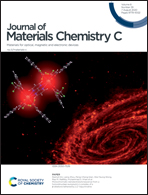Molecular salt crystals with bis(head-to-tail) interionic complementary assembly for efficient organic THz generators†
Abstract
We report new organic nonlinear optical salt crystals comprising bis(head-to-tail) complementary cation–anion assembly that results in extremely efficient THz wave generation. In the new salt crystals, each of the ends of the molecular anion, 4-(trifluoromethyl)benzenesulfonate, possesses bis(hydrogen-bond acceptors), while each of the ends of the nonlinear optical molecular cationic chromophore, 2-(4-(4-(hydroxymethyl)piperidin-1-yl)styryl)-3-methylbenzothiazol-3-ium, possesses bis(hydrogen-bond donors). The resulting assembly fulfills the requirements for efficient broadband THz wave generation, namely, perfectly parallel alignment of the nonlinear optical cationic chromophores for maximizing the optical nonlinearity as well as strong interionic binding interactions for reducing self-absorption of the generated THz waves. The new benzothiazolium crystals provide extremely high optical-to-THz conversion efficiency with a broad THz spectral bandwidth of 8 THz, where the peak-to-peak THz electric field amplitude is 36 times higher than that of the benchmark inorganic 1.0 mm-thick ZnTe crystal when pumped at 1300 nm and also notably higher than those of benchmark organic analogous crystals.



 Please wait while we load your content...
Please wait while we load your content...